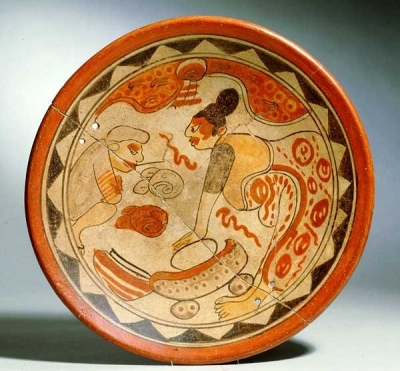
Cacao has carried deep cultural meaning since it was first domesticated. For the Olmec, an early Mexican Gulf Coast culture (1500 to 400 BC), this plant had geological, nutritional, spiritual, and economic significance. As the first society known to have domesticated the cacao tree, the Olmec found the crop to be spiritually and culturally significant in addition to being a healthful and delicious foodstuff. Theobromine (a chemical compound present in cacao) found in excavated Olmec pottery and at ancient burial sites revealed that cacao beverages were a staple in a variety of spiritual ceremonies (Powis 2011).
The question becomes, why cacao? According to the Popol Vuh, the Mayan creation text, the gods created humans from a combination of sweet things, maize, and cacao (Driess and Greenhill 2008, 18-22). In addition, many ancient artifacts depicted cacao offerings between gods such as the Mayan moon goddess IxChel and the rain god Chac who are seen trading cacao in an ancient Mayan depiction. This iconography rooted the tree’s capacity as a conduit of communication with the gods. Known as the “World Tree” or the “First Tree,” this crop became the tree of life and a cosmic metaphor linking the natural world to the spirit world. Thus, the offering of cacao functioned to symbolically connect diviners with the gods through ritual. The bounty of the cacao tree in Mesoamerica also created a metaphorical link to abundance, which was a request to the gods in agrarian and funerary rites. As Driess and Greenhill state, “Obsession with time and calendrical events fueled rituals during which cacao offerings helped to ensure the continuation of cosmic and agricultural cycles” (2008, 52). Cacao drinks were left in tombs and beans were used to adorn the bodies of the dead as it was believed that cacao had the power to energize the soul and aid in the transition to the supernatural world. The deep spiritual meaning of cacao catalyzed its importance in Olmec society.
Generally sought out for religious purposes by the Olmec, cacao didn’t become a food of conspicuous consumption until the Aztec and Mayan eras when cacao was served at feasts, weddings, birth ceremonies and other social occasions (Henderson 2015, 84). As the crop gained exposure, demand was created and soon cacao was present at nearly every commensal dining event, becoming a staple in the Mesoamerican diet. Popularly consumed as a beverage, the Olmec fermented the cacao with pulp intact. In the early days, cacao beverages were produced solely from the pulp of the fruit. The discovery of the more familiar chocolate drink might have been a happy accident as a by-product of the pulp brewing process (Edgar 2010).
After fermentation, cacao beans were mixed with water, vanilla, cinnamon, and sometimes a red chili. The beverage is generally made by women who dutifully raised the foam on the drink before consumption. The foam was thought to contain the essence of the wind god P’ee and still today, the amount of foam raised is a measure of a woman’s worth. After the drink was prepared and the foam was raised, the cacao beverage was ready for use in ceremony or prescribed as a remedy for ailments. Cacao was used to cure skin conditions, fever, seizures and in the most severe matters used to coax illness out of the body by appealing to the spirits with an offering of beans or a blended concoction containing the fruit (Dreiss and Greenhill 2008, 136).
Over time, chocolate has become a beverage enjoyed by cultures all over the world, but cacao was an incredibly significant crop to the Olmec during the Formative Period in Mesoamerica. The abundance, healing, and nutritional properties of the crop made it seem a true gift from the Gods, and created a foundation for its integration into the cultural identity and landscape of Mesoamerica.
Credit : Boston University
Picture Credit : Google




